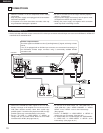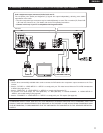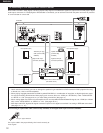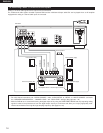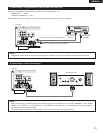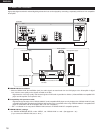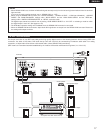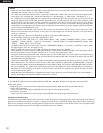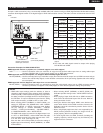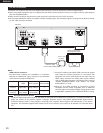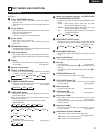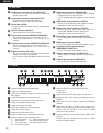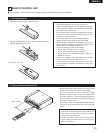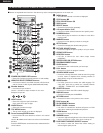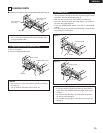
18
ENGLISH
NOTES:
•
Please use the included IEEE 1394 cable. When using a cable other than the included IEEE 1394 cable, please use a 4-pin IEEE
1394 cable with a length of 3.5 m or less for S400 or higher.
• The “IEEE 1394 audio signal (A&M protocol)” output from the DVD-3910’s IEEE 1394 connector not out video signals, please
connecting to a TV or Monitor with “component video output” or “S-video output” or “Video output”. (See pages 10, 11.).
•
The “IEEE 1394 audio signal (A&M protocol)” output from the DVD-3910’s IEEE 1394 connector can only be received on AV
equipment equipped with an IEEE 1394 connector. Digital video (DV), personal computer, and i-Link (a Sony trademark) audio
signals cannot be sent and received. Incorrect connections could lead to malfunction. Connect as instructed in the other device’s
operating manual. Note that there is no guarantee of the operation of the connection even between devices supporting IEEE
1394. Whether or not data and control signals can be transmitted and received between devices supporting IEEE 1394 depends
on the functions of the respective devices.
•
When connecting using the IEEE 1394 connector, only connect one cord between the two devices. Never connect two cords
between the two devices (loop connection). If this is done, the signal output from one device will return to the same device,
resulting in malfunction.
•
No audio signals are output from the DVD-3910’s analog connectors when IEEE 1394 is set.
To use the analog connectors, set the IEEE 1394 setting to “OFF”.
•
When using the IEEE 1394 mode, the “HDMI AUDIO SETUP” under “DIGITAL INTERFACE SETUP” and the “AUDIO
CHANNEL”, “DIGITAL OUTPUT”, “LPCM (44.1 kHz/48 kHz)”, “SOURCE DIRECT” and “BASS ENHANCER” settings under
“SETUP” – “AUDIO SETUP” cannot be made.
The digital output cannot be turned off even by setting “PURE DIRECT SELECT” to “ALL OFF” or selecting a mode for which
the digital output is set to off. (See pages 47, 48.)
•
When the IEEE 1394 connector is connected, the DVD-3910’s speaker settings are disabled.
•
During playback of a device supporting IEEE 1394, please do not disconnect the IEEE 1394 cable of the other device, do not
connect a new device, and do not switch the power on or off. Doing so may interrupt the audio.
•
Among the devices that support IEEE 1394, when the power is in the standby mode or off, some devices are not able to relay
data. Please see the operation manual of the connected device that supports IEEE 1394. This unit is not able to relay the IEEE
1394 data while in the standby mode.
•
Devices that support IEEE 1394 have the maximum data transfer speed supported by that device marked in the vicinity of the
IEEE 1394 connector. The maximum transfer speed of IEEE 1394 is defined as approximately 100/200/400 Mbps*, with 200
Mbps items having S200 inscribed and 400 Mbps items having S400 inscribed. The maximum IEEE 1394 data transfer speed of
this unit is 400 Mbps. The actual transfer speed may be slower than 400 Mbps when S100 or S200 devices are connected, or
depending on the specifications of the device. Try to ensure that connections are made between devices that have the same
maximum data transfer speed.
* Mbps (Mega bps) is an abbreviation of “Mega bits per second” and indicates the volume of data that can be communicated in 1
second. At 400 Mbps, 400 Mega bits of data is transferred in 1 second.
✽ The DVD-3910’s IEEE 1394 mode is designed based on IEEE Std. 1394a-2000, Standard for a High Performance Serial Bus.
✽ IEEE 1394 network
The following types of connections can be made between devices handling IEEE 1394 audio signals (A&M protocol):
q Daisy chain connections
Connect the sets in series using a single IEEE 1394 cord. Up to 15 sets can be connected.
w Tree (tower) connections
Connect the sets in parallel and in series using a single IEEE 1394 cord. Up to 63 sets can be connected.
Copyright Protection System
To play back through an IEEE 1394 connection the audio of Super Audio CD or DVD (except for discs that may be copied freely), both the
player and the amplifier are required to support a copyright protection system called DTCP (Digital Transmission Content Protection).
DTCP is copy protection technology comprising data encryption and the authentication of the remote device. This unit supports DTCP.
Please see the operation manual of your amplifier for information about your amplifier.



